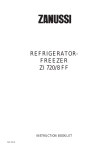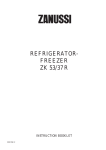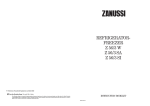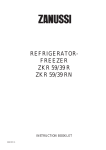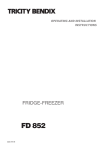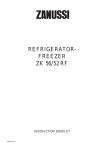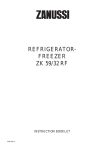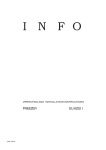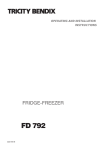Download Zanussi ZI 7243 Specifications
Transcript
REFRIGERATORFREEZER ZI 7243 INSTRUCTION BOOKLET 2222 216-83 IMPORTANT SAFETY INFORMATION It is most important that this instruction book should be retained with the appliance for future reference. Should the appliance be sold or transferred to another owner, or should you move house and leave the appliance, always ensure that the book is left with the appliance in order that the new owner can get to know the functioning of the appliance and the relevant safety information. This information has been provided in the interest of safety. You MUST read it carefully before installing or using the appliance. Installation ¥ ¥ ¥ ¥ ¥ ¥ This appliance is heavy. Care should be taken when moving it. It is dangerous to alter the specifications or attempt to modify this product in any way. Care must be taken to ensure that the appliance does not stand on the electrical supply cable. If the supply cord is damaged, it must be replaced by a special cable available from your local Service Force Centre. Any electrical work required to install this appliance should be carried out by a qualified electrician or competent person. Parts which heat up should not be exposed. Whenever possible, the back of the appliance should be close to a wall but leaving the required distance for ventilation as stated in the installation instructions. The appliance should be left for 2 hours after installation before it is turned on, in order to allow the refrigerant to settle. ¥ Maintenance and Cleaning ¥ Do not allow children to tamper with the controls or play with the product. ¥ Keep all packaging well away from children. During Use ¥ This appliance is designed for domestic use only, specifically for the storage of edible foodstuffs only. ¥ Frozen food must NOT be re-frozen once it has thawed out. ¥ Do not place carbonated or fizzy drinks in the freezer. ¥ Do not remove items from the freezer if your hands are damp/wet, as this could cause skin abrasions or frost/freezer burns. ¥ Ice lollies can cause Ôfrost/freezer burnsÕ if consumed straight from the freezer. ¥ ManufacturersÕ storage recommendations should be strictly adhered to. Refer to relevant instructions. 2 Switch off and unplug the appliance before carrying out any cleaning or maintenance work. Servicing ¥ This product should be serviced by an authorised engineer and only genuine spare parts should be used. ¥ Under no circumstances should you attempt to repair the machine yourself. Repairs carried out by inexperienced persons may cause injury or serious malfunctioning. Refer to your local Zanussi Service Force Centre and always insist on genuine spare parts. Child Safety ¥ The cooling plate or refrigerated freezer shelves in this appliance contain channels through which the refrigerant passes. If these are punctured this will cause substantial damage to the appliance and result in food loss. DO NOT USE SHARP INSTRUMENTS to scrape off frost or ice. Under NO circumstances should solid ice be forced off the lining or shelves. Solid ice should be allowed to thaw, when defrosting the appliance. See Defrost Instructions. At the end of the Appliance Life ¥ When disposing of your appliance, use an authorised disposal site. ¥ Remove the plug and ensure that any locks or catches are removed, to prevent young children being trapped inside. CONTENTS Instructions for the user Important Safety Information 2 Instructions for the installer Description of the appliance 4 Technical specification 14 Operation 5 Installation 15 Before using 5 Positioning 15 Setting the temperature 5 Electrical Connection 16 The freezer compartment 5 Freezing fresh food 5 Instruction for totally built-in appliances 17 Thawing 5 Making ice cubes 5 Inner Door Reversal 19 Normal operating sounds 5 Fresh food refrigeration 6 Movable shelves 6 Positioning the door shelves 6 Health and Safety Guidelines 8 Cool Check Guide 8 Maintenance and Cleaning 9 Internal cleaning 9 When the appliance is not in use 9 Changing the light bulb 9 Defrosting 9 Something not working 11 Service and Spare Parts 12 Customer Care 12 Guarantee Conditions 13 2222 216-83 3 DESCRIPTION OF THE APPLIANCE I H G A B F E D A- Dairy compartment B- Shelves C- Bottle storage shelf D- Salad drawers E- Glass shelf F- Storage shelves G- Cool check temperature guide H- Thermostat I- Freezer compartment 4 C OPERATION Before using Freezing fresh food Remove all securing tapes. Wash inside the appliance with lukewarm water and bicarbonate of soda (5 ml to 0.5 litre of water). It is not necessary to adjust the thermostat setting when freezing fresh food. In any 24 hours you can freeze up to 2 kg. Do not use soap or detergent as the smell may linger. Dry thoroughly. Caution Setting the temperature The temperature inside the refrigerator and the freezer is regulated by a single thermostat with 6 temperature positions and an ÒOFFÓ (O) position. Position 1 = minimum coldness Position 6 = maximum coldness In the event of a power cut the food in the freezer will not be affected if the power cut is short and if the freezer is full. Do not open the door. Should the food begin to thaw, it must be consumed quickly and must not be re-frozen (see page 9). Turn the thermostat dial to the required position. DEFROSTED COOKED FOOD MUST NOT BE REFROZEN. The intermediate position is usually the most suitable (3-4). Thawing The thermostat setting can vary as the temperature inside the refrigeration compartment depends on the following factors: Ð room temperature Ð how often the door is opened Ð how much food is stored Ð position of the appliance Important If the fridge is not defrosting correctly, it is possible that because a very low temperature has been selected, the motor is working continuously, which prevents the defrost cycle from operating. To ensure correct defrosting, a lower number should be selected on the thermostat and you should notice that the motor cuts out from time to time, which is correct. If you wish to return to a lower temperature, turn the thermostat to a higher number, however you should turn the setting lower occasionally to allow automatic defrosting. The freezer compartment The four-star freezer compartment is suitable for storage of commercially frozen food and for freezing fresh foods. Food can be thawed in a number of ways, depending on the type of food and the size of the packs. Meat, fish and fruit should be thawed in the refrigerator compartment and small pieces of meat or can even be cooked while still frozen, but you must ensure that it is thoroughly cooked through. Vegetables should be directly immersed in boiling water; ready-cooked dishes can be placed directly in the oven in their aluminium wrapping. A microwave oven is particularly suitable for thawing any type of frozen or deep-frozen food: follow the oven instructions, particularly regarding the placement of aluminium wrapping or containers in the oven. Making ice cubes The appliance is provided with two plastic ice cube trays. Fill the trays 3/4 full to allow the ice to expand and place them in one of the freezer drawers. To turn out the ice cubes simply give the tray a slight twist to release the cubes. Normal Operating Sounds ¥ You may hear faint gurgling or bubbling sounds when the refrigerant is pumped through the coils or tubing at the rear, to the cooling plate/evaporator or to the fixed freezer shelves. ¥ When the compressor is on, the refrigerant is being pumped round, and you will hear a whirring sound or pulsating noise from the compressor. ¥ A thermostat controls the compressor, and you will hear a faint ÕclickÕ when the thermostat cuts in and out. 5 Fresh food refrigeration To obtain the best performance, do not store warm food or evaporating liquids in the refrigerator; do cover or wrap the food, particularly if it has a strong flavour. Do not cover the shelves with any protective material, such as paper, cardboard or plastic, which may obstruct the air circulation through them. To help you use your refrigerator correctly, here are some more useful hints: Raw meat (beef, pork, lamb & wild fowl): wrap in polythene bags and place on top of the salad crisper. Meat can only be stored safely in this way for one or two days at the most. Fruit & vegetables: these should be thoroughly cleaned and placed in the bottom salad crispers. Butter & cheese: these should be placed in special airtight containers or wrapped in aluminium foil or polythene bags to exclude as much air as possible. Milk bottles: these should have a cap and should be stored in the bottle rack on the door. Movable shelves The walls of the refrigerator are equipped with a series of runners so that the shelves can be positioned as desired . For better use of space, the front half-shelves can lie over the rear ones. D338 Positioning the door shelves To permit storage of food packages of various sizes, the door shelves can be adjusted in height. To do this proceed as shown in the diagram. D007 The top shelf can be removed for easier cleaning. D009 6 HEALTH AND SAFETY GUIDELINES Because of consumer demand, preservatives have been removed from many pre-prepared foods. This together with the changes in shopping habits to a once-a-week shop, mean that safe handling and storage of food is even more important than ever. ¥ The fresh foods to be frozen must be fresh and of the best quality. ¥ The size of each pack should be small enough to ensure that it is used in one go . Small packs freeze more quickly and uniformly and give better results. The following tips should help you to ensure that the food in your home is in as perfect condition as possible. ¥ Frozen food, once thawed, must not be refrozen. Lean food keeps better and longer than fatty food, salt reduces the storage time. ¥ Wrap the food in polythene or aluminium freezing bags or foil so that they adhere to the food and provide an airlight seal . ¥ Packaging which is swollen or has traces of refrozen water droplets on the pack could indicate that the product has not been kept at a suitable temperature and that it may have lost its original quality. Partially thawed food must not be refrozen, it must be consumed within 24 hours. Never exceed the storage times indicated. ¥ Never place hot food, bottles or cans of fizzy drink in the freezer as they may explode. Containers with a lid must not be filled to the brim. ¥ Do not open the door or place extra fresh food in the freezer next to food which is already frozen as this could cause the temperature of the frozen food to rise and its quality and storage life to reduce . ¥ Keep the time between buying chilled food and placing it in your fridge as short as possible. Tests showed that the temperature of 1 1itre of orange juice rose to 22¡C in an hour between the supermarket and home. It then took 11 hours to get down to 7¡C in the refrigerator. ¥ Keep the refrigerator door closed as much as possible. ¥ Do not push food together too much, try to allow air circulate around each item. ¥ Cool cooked food as quickly as possible but do NOT place in the refrigerator or freezer until cool. (Leave food in a place as cool as possible in order that it can then be placed in the refrigerator or freezer as soon as possible). ¥ Do NOT mix raw and cooked meat, they must be in separate containers. Take care not to let the meat juices drip onto other food. If the meat does drip, remove everything and clean thoroughly. ¥ Do not store food uncovered. ¥ The best way to defrost food is to put it in the refrigerator to thaw slowly. ¥ Remove suspect food from your refrigerator and clean (Keps to ÒMaintenance & CleaningÓ). ¥ Never allow spillages to dry and harden. ¥ Ensure that food placed in the freezer is dated and labelled and used in date order to ensure that food is consumed at its best. ¥ It is important that food is used before its Òbest beforeÓ date. ¥ Store eggs in the egg rack provided in the refrigerator door. Discard any broken or chipped eggs. ¥ Regularly check the refrigerator door seal to ensure that it is clean and free from debris. ¥ Always wash your hands with soapy water and dry them with a clean towel before handling food. ¥ Keep work surfaces clean and avoid cross contamination by not using the same work surface or knife, without washing them thoroughly in between. 7 7 Cool Check Guide The guide consists of a temperature sensitive strip sealed in a shelf trim. When the fridge is operating at the safe temperature to store food the guide will appear black. If the temperature rises above this level the guide will show the words TOO WARM. TOO WARM Positioning of the Cool Check The shelf with the cool check temperature guide must be placed in the fridge according to the instructions located on the fridge wall and always ensure the guide is at the front. If the Cool Check shows TOO WARM In certain conditions the temperature guide may show TOO WARM if: ¥ The fridge is switched off ¥ The door has been recently opened ¥ A quantity of warmer food has been introduced to the fridge ¥ The fridge temperature is above the recommended maximum for the safer storage of food. The cool check will change to show ÒTOO WARMÒ very quickly after the door has been opened. It will however take a number of hours to return to black, indicating that the temperature is correct. The appliance should be left overnight and the cool check examined in the morning. If the cool check shows TOO WARM, turn the appliance to a colder setting leave overnight and examine again the following morning. Hints and Tips ¥ The guide is only suitable for use in the model supplied. ¥ The guide will not operate in the freezer compartment. ¥ When cleaning the shelf take care not to immerse in water, and wipe away any spills. 8 ZA NU SS I CCOO2 MAINTENANCE AND CLEANING Before any maintenance or cleaning work is carried out, DISCONNECT the appliance from the ELECTRICITY supply. Internal cleaning Clean the inside and accessories with warm water and bicarbonate of soda (5ml to 0.5 litre of water). Rinse and dry thoroughly. Defrosting Refrigerator The refrigerator automatically defrosts every time the compressor stops. The water is discharged, via the pipe, into a tray located at the back of the appliance above the compressor, where it evaporates. NEVER USE DETERGENTS, ABRASIVE POWDERS, HIGHLY PERFUMED CLEANING PRODUCTS OR WAX POLISHES, TO CLEAN THE INTERIOR AS THESE WILL DAMAGE THE SURFACE AND LEAVE A STRONG ODOUR. When the appliance is not in use When the appliance is not in use for long periods, disconnect from the electricity supply, empty all foods and clean the appliance, leaving the doors ajar to prevent unpleasant smells. Changing the light bulb Should the interior light fail to work, first switch off the appliance and disconnect from the electricity supply, then replace the bulb as follows; D037 Important To avoid defrost water overflowing into the fridge, periodically clean the water discharge hole in the centre of the V shaped drip collector at the back of the refrigerator compartment behind the fruit and vegetable drawer. Use the defrost cleaner provided which you will find already inserted into the discharge hole. Remember to wash the defrost cleaner in hot soapy water at regular intervals. Dry throughly before replacing. Freezer When the frost has reached a thickness of up to 4mm it can be removed using the ice scraper provided with the appliance. During this operation it is not necessary to disconnect the appliance from the mains and remove the food. Never use metal tools for this operation. D411 Unscrew the light cover and then pull it outward by pressing as shown in the figure. Unscrew the bulb and replace it with a new 15 watt bulb (available from your nearest Service Force Centre). Replace the light cover by sliding it into its original position and replacing the screw. For complete defrosting (once or twice a year) proceed as follows: - turn the thermostat dial to the ÇOFFÈ position (O) or disconnect the appliance from the mains. - Remove any food from inside the freezer and fridge, wrap it in several sheets of newspaper and store in a cool,dry place. - Leave the door open, place a basin on the top shelf of the refrigerator compartment, under the drain hole, lift the plug as shown in the fig. 9 - Clean and dry thoroughly. - Replace the scraper in one of the drawers . - Reconnect the appliance to the mains or reset the thermostat to a functioning position. - After letting the appliance run for a least half an hour, replace the previously removed food into the compartment. Important When defrosting the freezer, the fridge is also controlled by the thermostat and will not be operational during this period. A temperature rise of the frozen food packs, during defrosting, may shorten their safe storage life. Important ÇIn the event of a power failure causing the temperature within your freezer to rise, do not refreeze the food without checking its condition. The following guidelines should assist you.È Ice-cream: once thawed should be discarded. Fruits & Vegetables: if soft should be cooked and used up. Breads & Cakes: can be re-frozen without danger. Shellfish: should be refrigerated and used up quickly. Cooked Dishes: i.e. casseroles should be refrigerated and used up. Large Pieces of Meat: can be re-frozen providing there are still ice crystals remaining within them. Small Joints: should be cooked and can then be refrozen as cooked dishes. Chicken: should also be cooked and re-frozen as a cooked dish. 10 PR151 SOMETHING NOT WORKING Important: If you call out an engineer to a fault listed below, or to repair a fault caused by incorrect use or installation a charge will be made, even if the appliance is under guarantee. Before contacting your local Service Force Centre, check the following points: Symptom Solution No power to the appliance Check there is power at the socket. Check there is not a power cut by checking the household lights. Check the fuse has not blown. The light does not come on Ensure that the bulb is correctly fitted. Replace the bulb if it has blown. Check the door light switch is not jammed. The temperature in the fridge or freezer section is too high Check the temperature in the fridge is turned to the correct setting relative to ambient conditions. Check the ambient temperature is within the applianceÕs operating limits of 10¡C to 32¡C. The compressor runs continously Adjust the thermostat to give correct temperature control. See ÒSetting the temperatureÓ. Check that the doors are closed. Large quantities of food have recently been placed in the cabinet/and or door is frequently opened. Check that air ventilation is not obstructed. Excessive frost and ice has built up Ensure the doors are not left open. Check that nothing is preventing the doors from closing. Is the door gasket intact and clean. Noise Refer to normal operating sounds. Water under the salad bin Check the drain hole is not blocked. (see Maintenance and Cleaning). If, after the above checks, there is still a fault, call your local Service Force Centre. In-guarantee customers should ensure that the above checks have been made as the engineer will make a charge if the fault is not a mechanical or electrical breakdown. Please note that proof of purchase is required for any in-guarantee service calls. 11 SERVICE AND SPARE PARTS In the event of your appliance requiring service, or if you wish to purchase spare parts, please contact your local Zanussi Service Force Centre by telephoning:- 0870 5 929929 Your telephone call will be automatically routed to the Service Force Centre covering your post code area. For further details please see the accompanying Customer Care Booklet. Before calling out an engineer, please ensure you have read the details under the heading ÔSomething Not Working? When you contact the Service Force Centre you will need to give the following details: 1. Your name, address and post code 2. Your telephone number 3. Clear and concise details of the fault 4. The model and serial number of the appliance (found on the rating plate) 5. The purchase date CUSTOMER CARE DEPARTMENT For general enquiries concerning your Zanussi appliance or for further information on Zanussi products, please contact our Customer Care Department by letter or telephone as follows:Customer Care Department Zanussi 55-77 High Street Slough Berkshire SL1 1DZ Tel: 08705 727 727 12 GUARANTEE CONDITIONS Standard guarantee conditions We, Zanussi, undertake that if within 24 months of the date of the purchase this Zanussi appliance or any part thereof is proved to be defective by reason only of faulty workmanship or materials, we will, at our option repair or replace the same FREE OF CHARGE for labour, materials or carriage on condition that: The appliance has been correctly installed and used only on the electricity supply stated on the rating plate. The appliance has been used for normal domestic purposes only, and in accordance with the manufacturerÕs instructions. The appliance has not been serviced, maintained, repaired, taken apart or tampered with by any person not authorised by us. All service work under this guarantee must be undertaken by a Zanussi Service Force Centre. Any appliance or defective part replaced shall become the CompanyÕs property. This guarantee is in addition to your statutory and other legal rights. Home visits are made between 8.30am and 5.30pm Monday to Friday. Visits may be available outside these hours in which case a premium will be charged. Exclusions This guarantee does not cover: Damage or calls resulting from transportation, improper use or neglect, the replacement of any light bulbs or removable parts of glass or plastic. Costs incurred for calls to put right an appliance which is improperly installed or calls to appliances outside the European Community (EC) or European Free Trade Area. Appliances found to be in use within a commercial environment, plus those which are subject to rental agreements. Products of Zanussi manufacture which are not marketed by Zanussi. European Guarantee If you should move to another country within Europe then your guarantee moves with you to your new home subject to the following qualifications: The guarantee starts from the date you first purchased your product. The guarantee is for the same period and to the same extent for labour and parts as exists in the new country of use for this brand or range of products. This guarantee relates to you and cannot be transferred to another user. Your new home is within the European Community (EC) or European Free Trade Area. The product is installed and used in accordance with our instructions and is only used domestically, i.e. a normal household. The product is installed taking into account regulations in your new country. Before you move please contact your nearest Customer Care centre, listed below, to give them details of your new home. They will then ensure that the local Service Organisation is aware of your move and able to look after you and your appliances. France Senlis +33 (0)3 44 62 29 99 Germany NŸrnberg +49 (0)911 323 2600 Italy Pordenone +39 (0)1678 47053 Sweden Stockholm +46 (0)8 738 79 50 UK Slough +44 (0)1753 219 897 13 TECHNICAL SPECIFICATIONS POWER SUPPLY VOLTAGE AND FREQUENCY 220-240 V / 50 Hz TOTAL POWER ABSORBED 120 W AVERAGE DAILY UNITS ELECTRICITY * 0.88 kWh GROSS CAPACITY Fridge Freezer 220 l 17 l NET CAPACITY Fridge Freezer 195 l 17 l STAR RATING * This figure is based on standard test results in accordance with European Standard EN 153. Actual consumption will depend on how the appliance is used and where it is located. 14 INSTALLATION Warning IF YOU ARE DISCARDING AN OLD APPLIANCE THAT HAS A LOCK OR CATCH ON THE DOOR, YOU MUST ENSURE THAT IT IS MADE UNUSABLE TO PREVENT YOUNG CHILDREN BEING TRAPPED INSIDE. Depending upon the position which you choose for your appliance, you may wish to reverse the way in which the door opens. To do this, refer to instructions on ÒDoor reversal directionsÓ. Positioning This appliance is designed to operate in ambient temperatures between 10¡C (50¡F) and 32¡C (90¡F). It should be located in a dry atmosphere, out of direct sunlight and away from extreme temperature e.g. not next to a cooker or other sources of direct heat, or in a very cold room e.g. an outhouse, where the temperatures may fall below 10¡C (50¡F). If these temperatures are exceeded i.e. colder or warmer, then the appliance may not operate correctly. For building-in and door reversibility, if necessary , refer to the relevant instructions in the following pages. 15 Electrical connections Any electrical work required to install this appliance should be carried out by a qualified electrician or competent person. WARNING: THIS APPLIANCE MUST BE EARTHED. The manufacturer declines any liability should this safety measure not be observed. If the plug that is fitted to your appliance is not suitable for your socket outlet, it must be cut off and the appropriate plug fitted. For replacement, use a 13amp BSI362 fuse. Only ASTA or BSI approved fuses should be used. The plug must not be used if the fuse cover/carrier is lost. The cover/carrier is indicated by the coloured insert at the base of the plug. A replacement cover/carrier must be obtained from your local Zanussi Service Force Centre whose address is listed in the Customer Care Booklet which accompanies your instruction manual. This appliance complies with the E.E.C. Directive No. 87/308 of 2.6.87 relative to radio interference suppression. This appliance complies with the following E.E.C. Directives: Remove the fuse from the cut off plug. The cut off plug should then be disposed of to prevent the hazard of shocks in case it should be plugged into a 13amp socket in another part of your home. Important The wires in the mains lead are coloured in accordance with the following code: Green and Yellow - Earth Blue - Neutral Brown - Live If you fit your own plug, the colours of the wires in the mains lead of your appliance may not correspond with the markings identifying the terminals in your plug, proceed as follows: 13 AMP. FUSE 13 AMP GREEN & YELLOW BROWN BLUE D207 CORD CLAMP Connect the Green and Yellow (earth) wire to the terminal in the plug which is marked with the letter ÇEÈ or the earth symbol yellow. or coloured green and Connect the blue (neutral) wire to the terminal in the plug which is marked with the letter ÇNÈ or coloured black. Connect the brown (live) wire to the terminal in the plug which is marked with the letter ÇLÈ or coloured red. The plug moulded onto the lead incorporates a fuse. 16 - 73/23 EEC of 19.2.73 (Low Voltage Directive) and subsequent modifications; - 89/336 EEC of 3.5.89 (Electromagnetic Compatibility Directive) and subsequent modifications. Please ensure that when the appliance is installed it is easily accessible for the engineer in the event of a breakdown. Instructions for totally built-in appliances min. 200 cm 2 Recess dimensions 50 mm Height Depth Width 1225 mm 550 mm 560 mm The applianceÕs door has been locked in position for transport by means of pins on both sides. According to the door opening direction, remove relevant pins at the top and at the bottom. min. cm 200 2 D567 To ensure adequate ventilation, allow the clearances shown in figure. 50 540 Furthermore, it is necessary that the cabinet has a ventilation recess with the following dimensions: depth 50 mm width 540 mm B T H PR01 Push appliance into housing until stop strip (A) touches the kitchen unit. A D022 Open the door and push the appliance against the side of the kitchen unit opposite to that of appliance hinges. Fasten the appliance with 4 screws provided in the kit included with the appliance. Snap ventgrille (C) and hinge cover (D) into position D C D727 17 Press in the joint covers between the appliance and the kitchen unit. D724 Apply covers (B) on joint cover lugs and into hinge holes. B D726 Position the runners (A) at the top and bottom of the inside of the kitchen unit as shown in the diagram and mark the position of the external holes. After preparing the holes, screw the runners to the kitchen unit door using 3.5x16 mm screws. A 20m m PR33 Open both the appliance door and that of the kitchen unit to approx. 90¡. Place the little plates over the runners. Hold the doors of the appliance and the unit together and mark the holes. 8mm PR34 Remove the little plates and make the holes with a diam. of 2 mm. Replace the little plates over the runners and screw in the screws provided (3.5x16 mm). For the alignment of the kitchen unit door, if necessary, use the clearance size of the slotted holes. At the end of the procedure, check that the doors of the appliance and the kitchen unit open properly. PR35 18 Inner door reversal Using a screwdriver release bracket (1) by pressing on the internal spring and withdraw it from its seat together with the door; remove plug (2) and fit it in the hole left open on the opposite side; 180° 2 turn the door through 180¡, remove the bracket (1) and refit it on the opposite side. 1 Refit the door and insert the top pin and bottom bracket (1), pushing it into place. PR140 To ensure correct storage of food, the door is fitted with a simple spring device which holds it in the open position until it is properly closed. 19



















